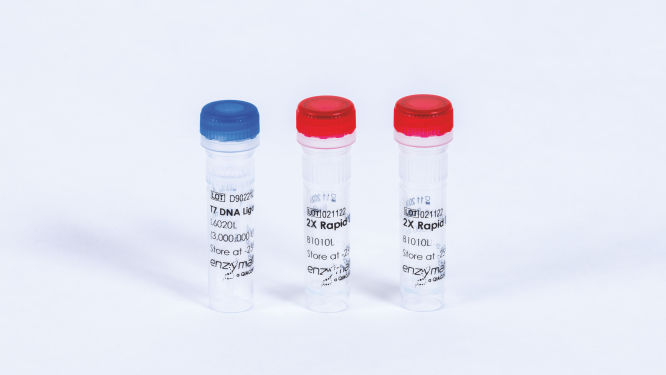Cat. No. / ID: L6020L
Features
- Only joins efficiently cohesive-end termini
- Low efficiency joining blunt ends
- Repair single-stranded nicks in duplex DNA
Product Details
T7 DNA Ligase catalyzes the formation of a phosphodiester bond between a 5ʹ phosphate and a 3ʹ hydroxyl termini in duplex DNA. The enzyme only efficiently joins cohesive end termini and repairs single-stranded nicks in duplex DNA. It is not very effective at catalyzing blunt end ligation. However, adding high concentrations of PEG 6000 at ≥ 20% (w/v) can stimulate T7 DNA Ligase activity and lead to measurable results. Generally, under normal reaction conditions, T7 DNA Ligase cannot carry out blunt-end DNA ligation, which makes it a suitable option for cases where both blunt and cohesive ends of DNA are present. Still, only cohesive ends need to be joined.
This enzyme is supplied in 20 mM Tris-HCl, 50 mM NaCl, 1 mM DTT, 0.1 mM EDTA and 50% glycerol; pH 7.5 at 25°C.
The 2x Rapid Ligation Buffer contains 132 mM Tris-HCI, 20 mM MgCl2, 2 mM DTT, 2 mM ATP and 15% PEG 6000; pH 7.6 at 25°C.
Performance
- Storage temperature: –25°C to –15°C
- Molecular weight: 41,132 Daltons
| Test | Units tested | Specification |
|---|---|---|
| Purity | n/a | >99% |
| Specific activity | n/a | 3,000,000 U/mg |
| Single-stranded exonuclease | 30,000 U | <1% released |
| Double-stranded exonuclease | 30,000 U | <1% released |
| Double-stranded endonuclease | 30,000 U | No conversion |
| E. coli DNA contamination | 30,000 U | <10 copies |
Principle
The protein is produced by a recombinant E. coli strain carrying the T7 DNA Ligase gene.
One unit is defined as the amount of T7 DNA Ligase required to ligate 50% of 100 ng DNA fragments with cohesive termini in 30 minutes at 23°C.
Procedure
Usage Instructions
Sticky-end ligation of cut vector and insert. Recommended DNA molar ratio, vector: insert = 1: 3
1. Set up the following reaction mixture in a total volume of 20 µL (add the ligase last):
- 10 µL 2x Rapid Ligation Buffer (B1010)
- 50 ng vector DNA
- 3-fold molar excess of insert DNA
- 1 µL T7 DNA Ligase (L6020L)
- Nuclease-free water up to 20 µL
2. Incubate the reaction mixture at 25°C for 15–30 minutes.
3. Leave the ligated product on the ice and transform 1-5 µL of the product into 50 µL of competent cells. Alternatively, the ligation product can be purified using the appropriate method or stored at –20°C.
Notes:
1. T3 DNA Ligase is supplied with 2x Rapid Ligation Buffer for ligation reactions. Activity is very low in the absence of PEG (1).
2. T7 DNA Ligase cannot ligate single-stranded DNA fragments (1).
3. Heat inactivation reduces transformation efficiency dramatically.
4. In the absence of high-concentration crowding agents (e.g., 20–30% PEG 6-8000), the specific activity of T7 DNA Ligase is reduced by 1000-fold on blunt-ended fragments (1–2).
Quality Control
Unit activity was measured using a twofold serial dilution method. The enzyme was diluted in 1x Rapid Ligation Buffer and added to 20 µL reactions containing double-stranded DNA fragments and 1x Rapid Ligation Buffer. Reactions were incubated for 30 minutes at approximately 23°C, placed on ice, and analyzed on a 1% agarose gel stained with ethidium bromide.
Protein concentration is determined by OD280 absorbance.
Physical purity is evaluated by SDS-PAGE of concentrated and diluted enzyme solutions followed by silver-stain detection. Purity is assessed by comparing the aggregate mass of contaminant bands in the concentrated sample to the band's mass corresponding to the protein of interest in the diluted sample.
Single-stranded exonuclease is determined in a 50 µL reaction containing a radiolabeled single-stranded DNA substrate and 10 µL of enzyme solution incubated for 4 hours at 37°C.
Double-stranded exonuclease activity is determined in a 50 µL reaction containing a radiolabeled double-stranded DNA substrate and 10 µL of enzyme solution incubated for 4 hours at 37°C.
Double-stranded endonuclease activity is determined in a 50 µL reaction containing 0.5 µg of plasmid DNA and 10 µL of enzyme solution incubated for 4 hours at 37°C.
E. coli contamination is evaluated using 5 µL replicate samples of enzyme solution that are denatured and screened in a TaqMan qPCR assay for the presence of contaminating E. coli genomic DNA using oligonucleotide primers corresponding to the 16S rRNA locus.
Applications
This product is available for molecular biology applications such as:
- Cloning ligation
- Adding linkers or adapters to double-stranded DNA
- Nick-sealing in double-stranded DNA
References
1. Doherty, A. et al. (1996) J.Biol. Chem 271:11083.
2. Dayal, T. Unpublished observations.

